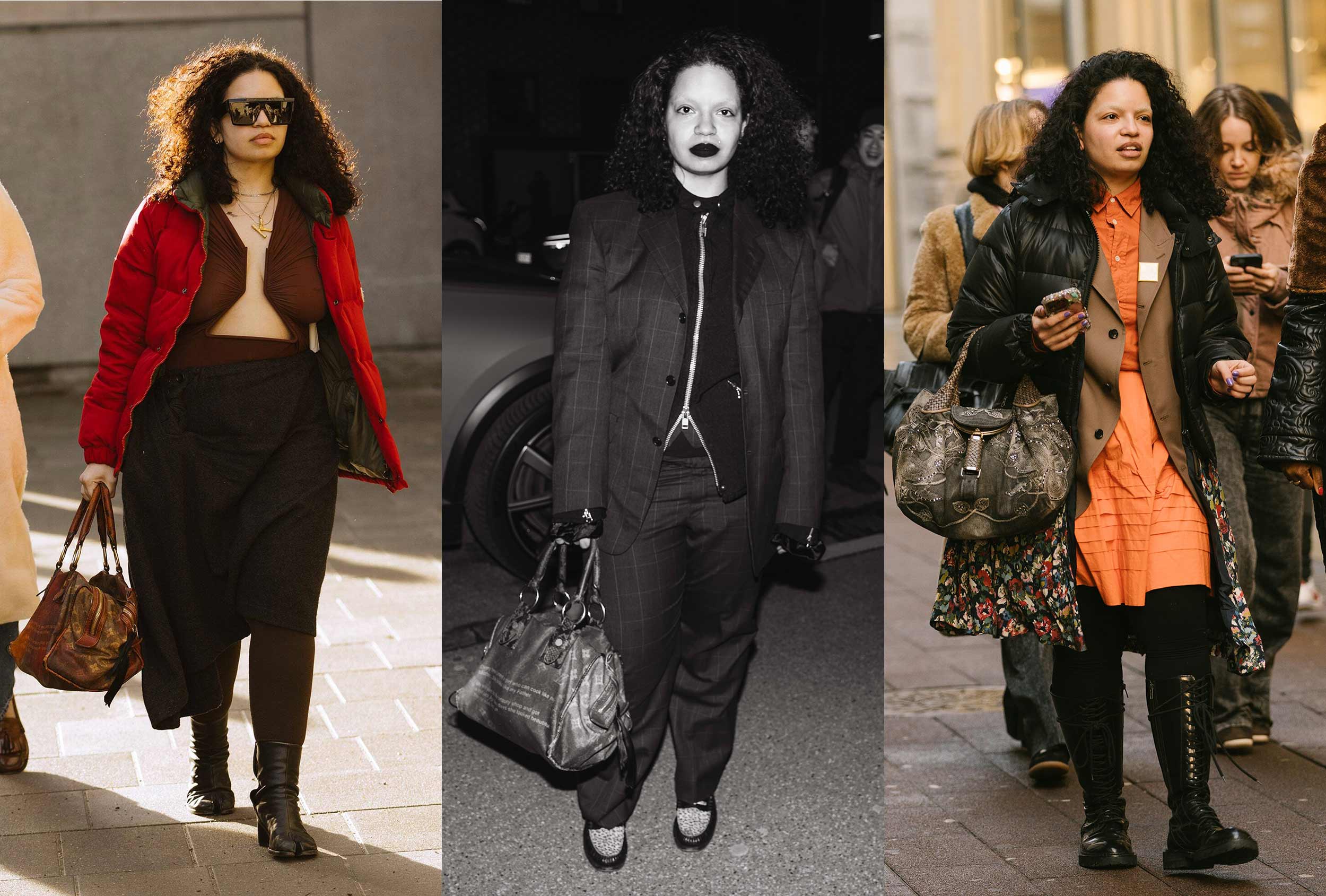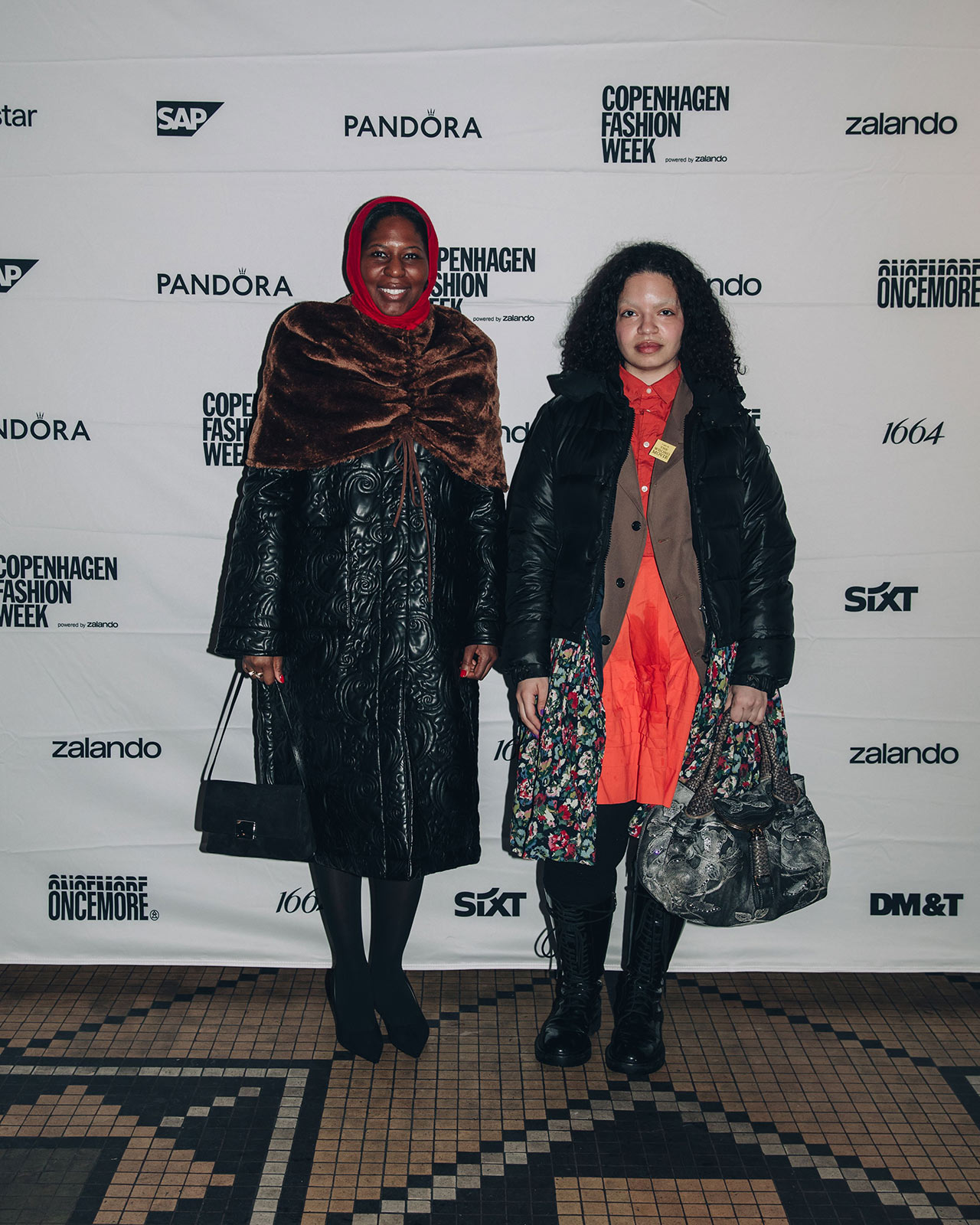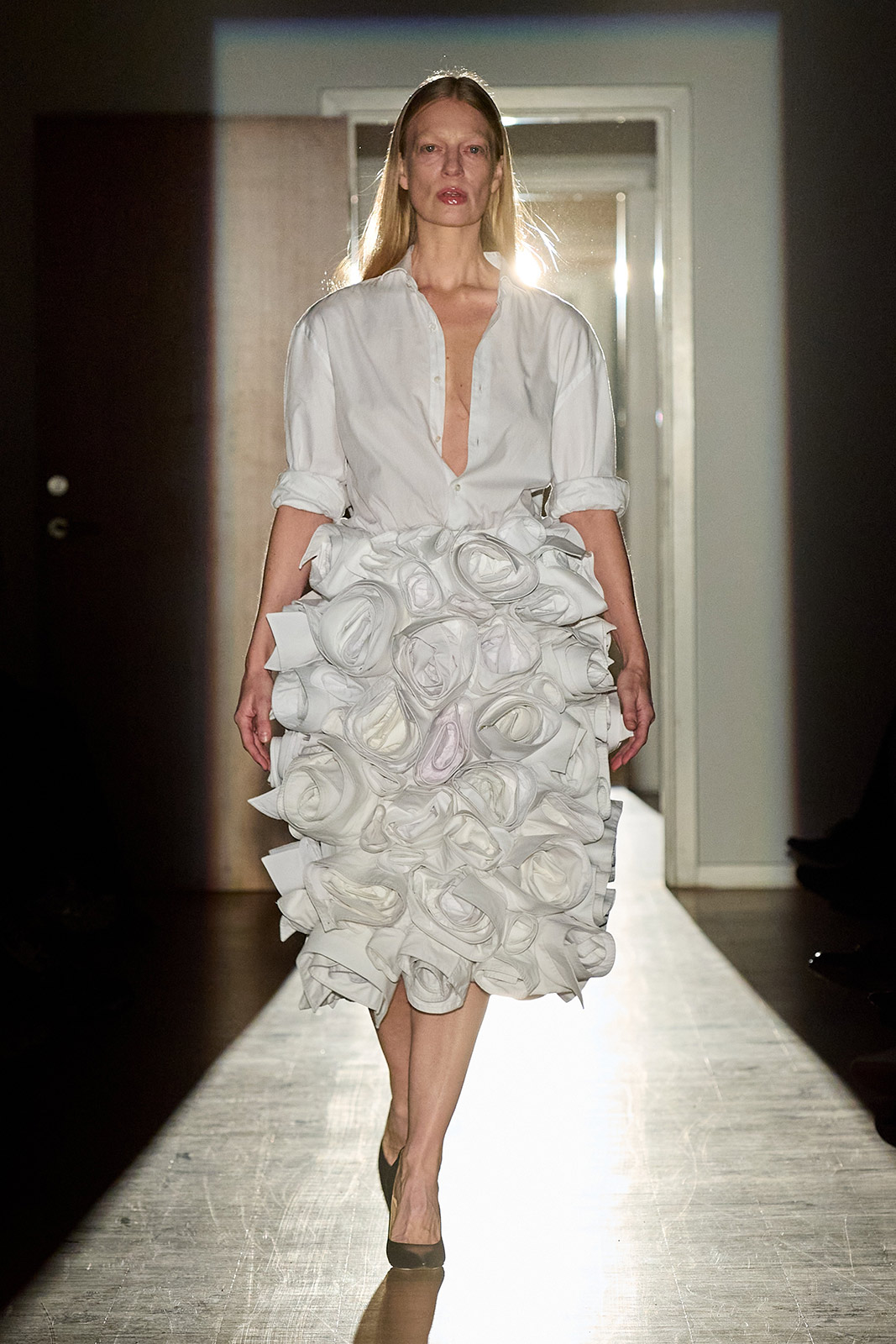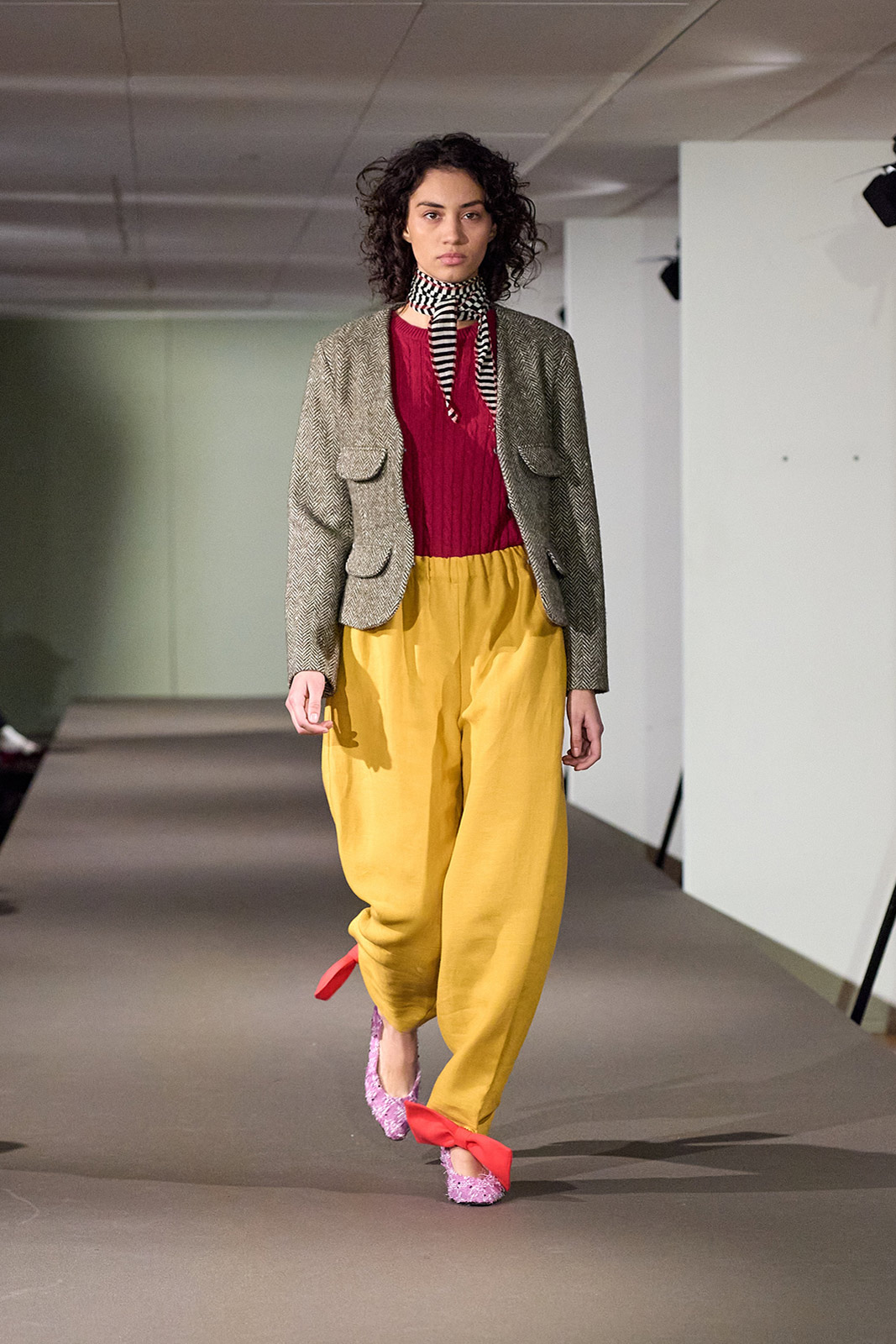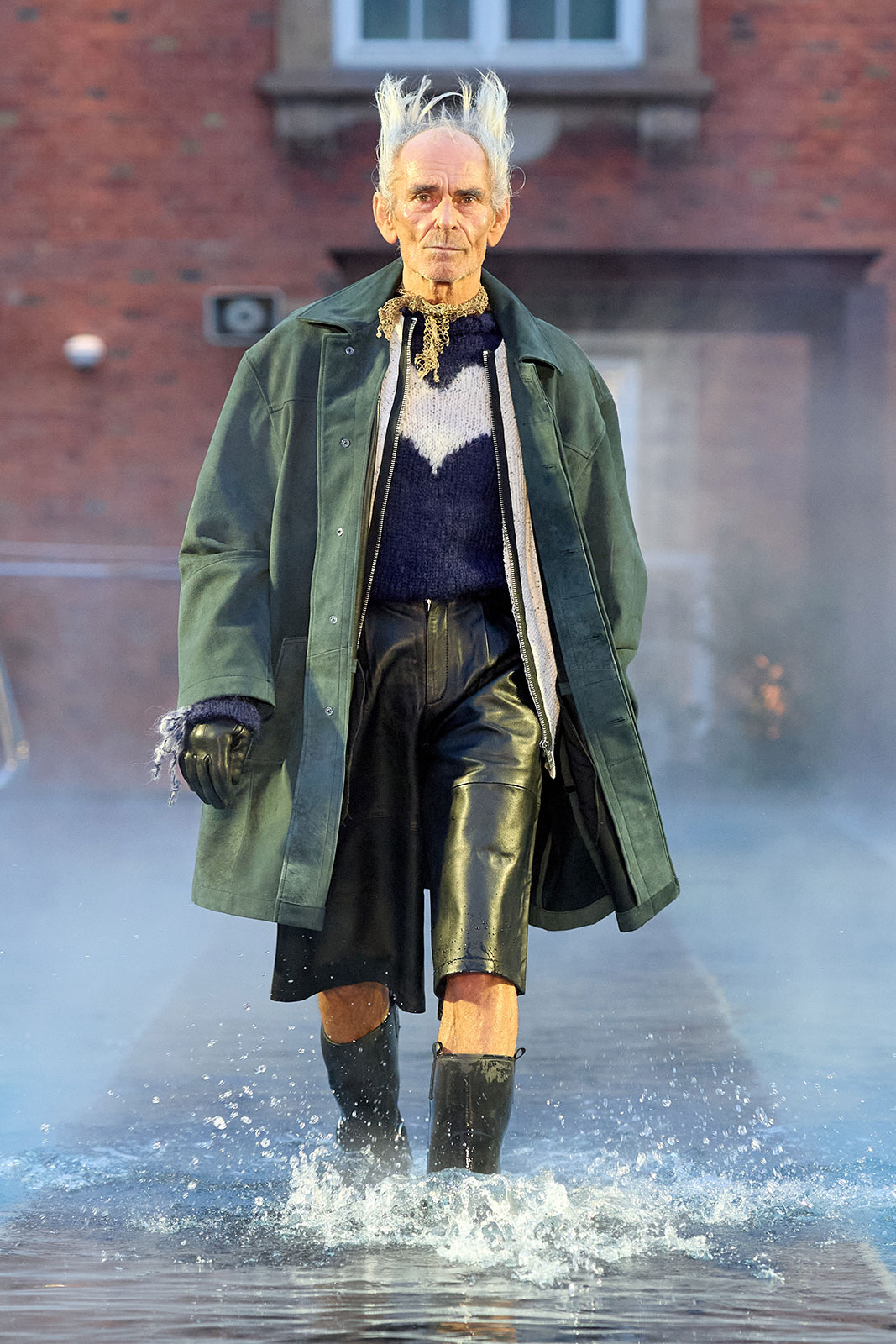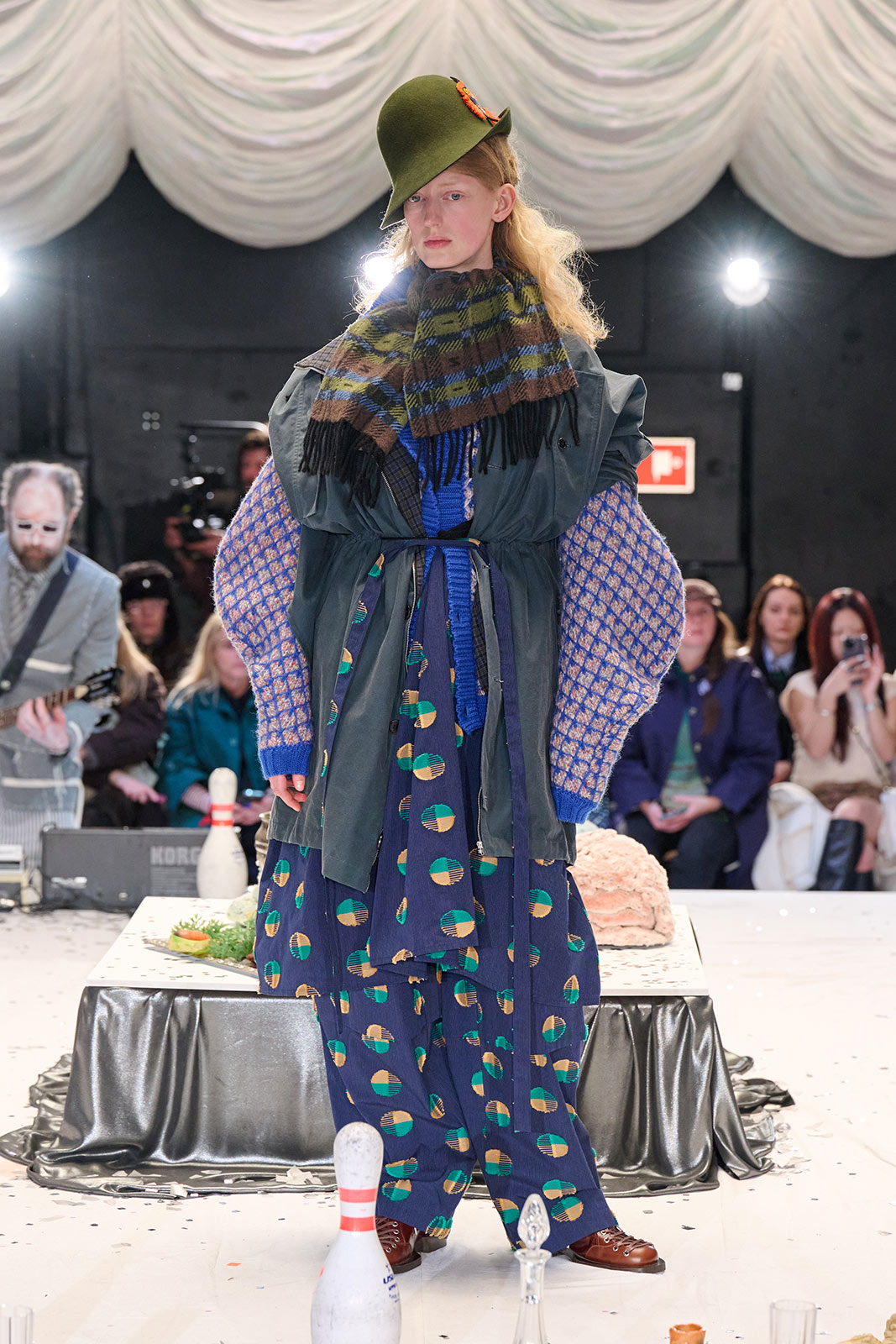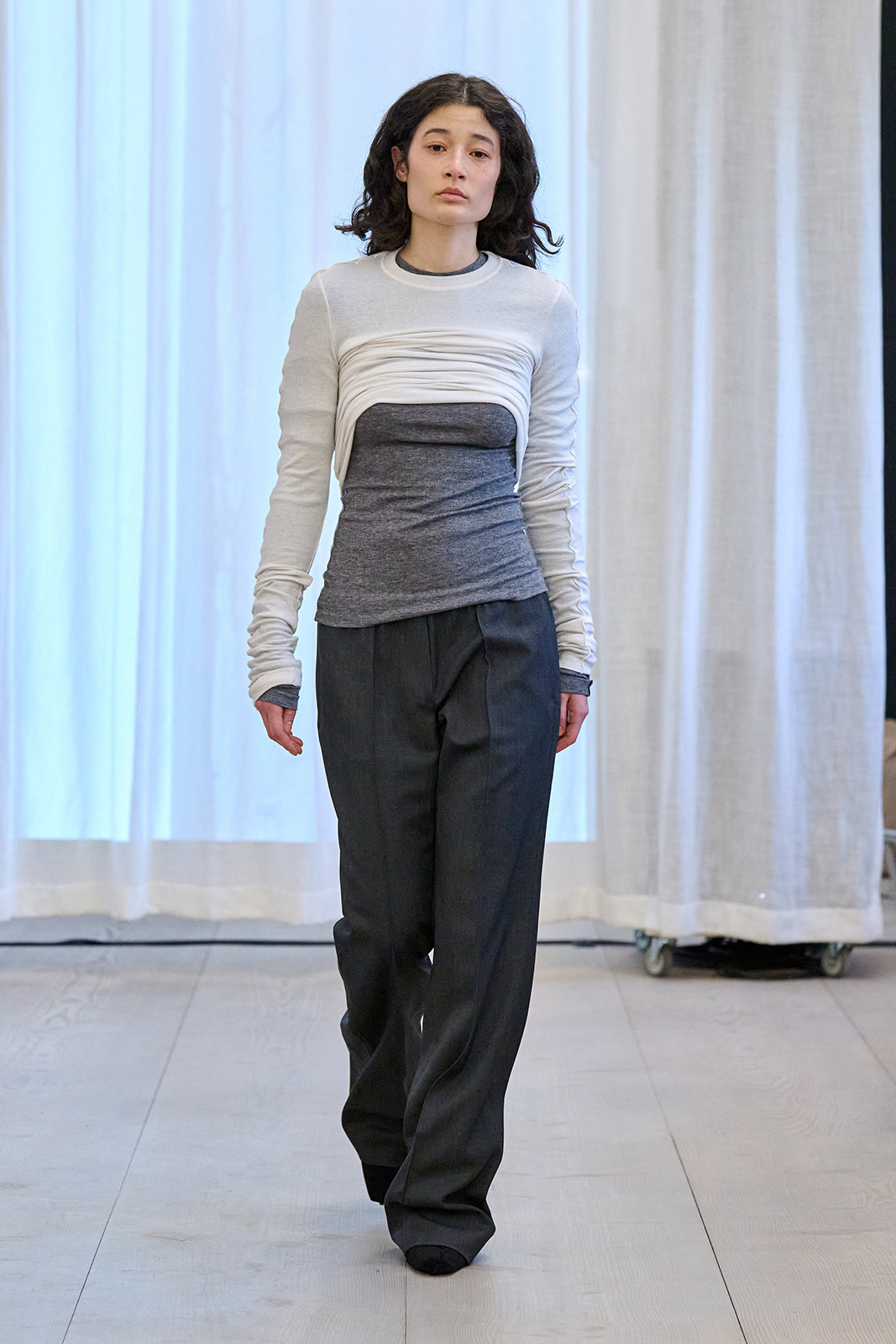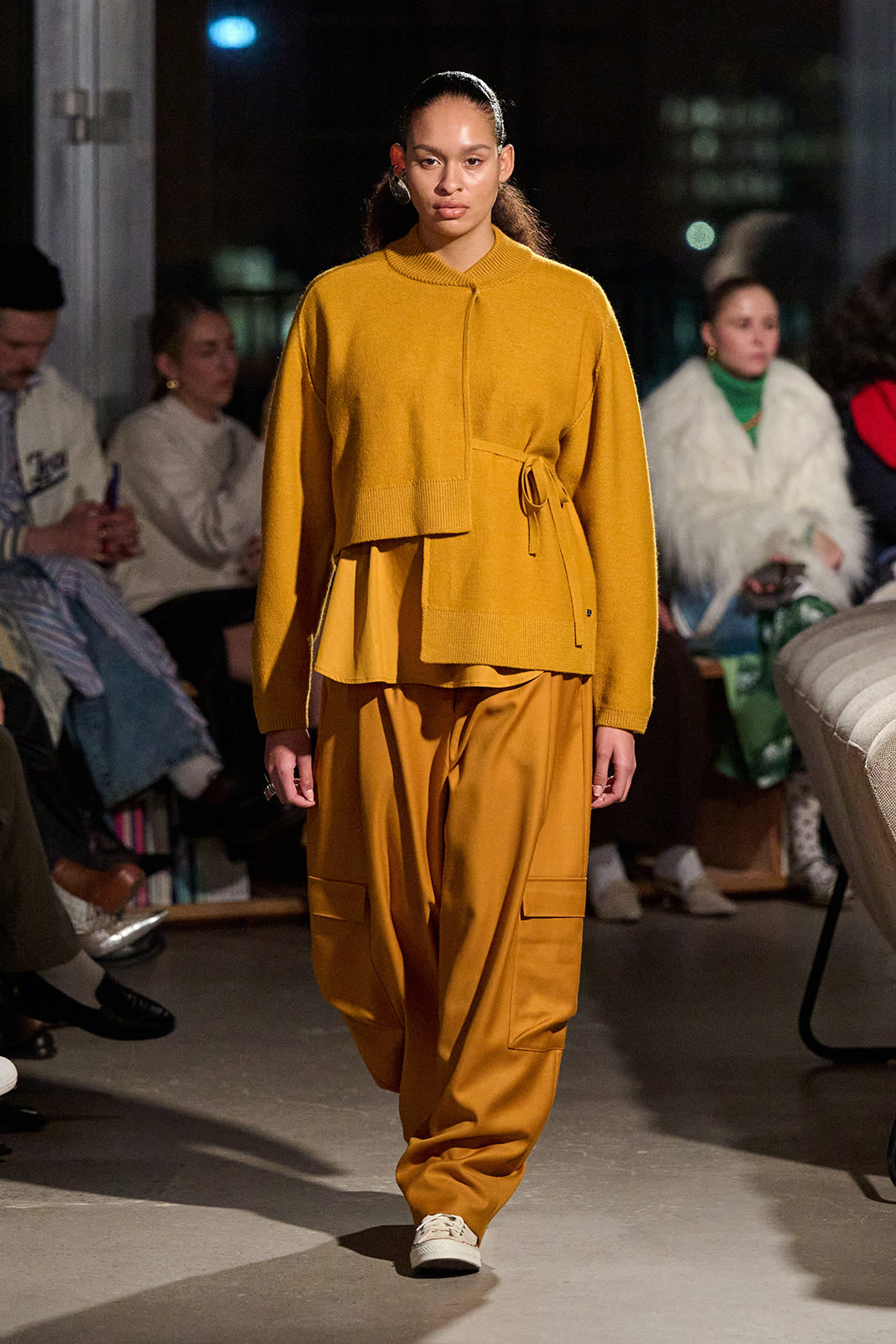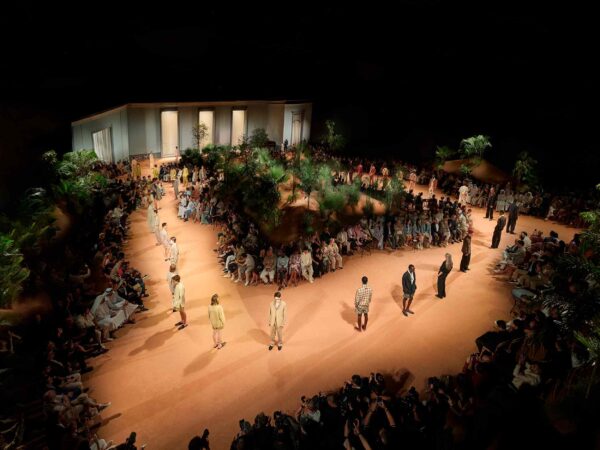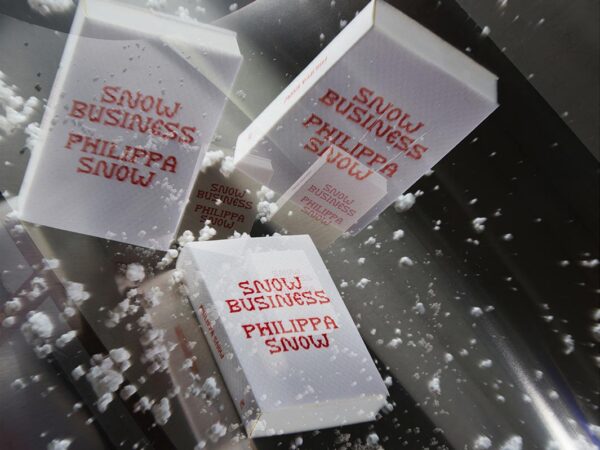Associate Editor Maya Kotomori shares the disproven thought experiments from CPHFW Autumn/Winter 2025
I wish I could charge the sun with assault and battery. 6am EST, and for whatever reason, I am awake though my flight to Copenhagen doesn’t leave until 5:15pm. I am traveling to the Danish city on behalf of Copenhagen Fashion Week’s Hospitality Program for a week of shows, appointments, and semi-professional friend-making; all of my specialties. In bed, I roll away from the beams of light that stream directly into my eyes, realizing three things apart from the fact that I very obviously forgot to put on my eye mask the night prior: I needed curtains, I also forgot to put on my bonnet and would need to refresh my curls before flying, and most urgently, I needed to pack.
The next eight hours before leaving for the airport were crucial, and I crushed every single one of them with my trademark pre-travel efficiency. While my hair air-dried I consult my planner to ponder the week ahead: 26 shows, three breakfasts, two dinners, afterparties TBD upon pinchy shoe-induced foot pain at the end of each day. What last year felt like an anxious buzz ahead of fashion week now feels like a steady, soothing vibration, like falling asleep leaned up against the window of a city bus seat (I Ubered to JFK International, though). I don’t have any problems with the TSA and have enough time to call my mom before boarding, though I miss my chance to catch the once-in-a-century planetary alignment I learned about hours prior to leaving via the internet. I dozed off on the plane thinking about the galaxy.
Upon landing at 7:41am at CPH International airport, the sunshine still feels like an assault though the sky looks beautiful and the air is clean—still no planets. I am joined by Laird Borrelli-Persson of Vogue Runway in our CPHFW official car, a Polestar (for the uninitiated, think equal parts Tesla and BMW’s electric range but sans Nazi attachments) hatchback prototype that is yet to appear on the market. Like me, Borrelli likes getting-to-know-you small talk at any hour, and we engage in a lovely chat about music and the state of the industry. I tell her about how I’m listening to early-’90s Texan alt-rock band Toadies and she puts me on to The Latin Kings, a Swedish hip-hop group from the suburbs of Stockholm that is definitely not to be confused with the prolific street gang.
In mere minutes we arrive at 25Hours Hotel Indre By, a boutique hospitality operation reminiscent of The Standard in kitsch-chicness, except replace the ’70s space age interiors for an eclectic blend of funky folk art and warm-toned MCM. My room smells like taking a deep breath from the bottom of a well-used Diptyque candle. Today’s lack of shows allows me time to nap well into the afternoon, get a manicure inside Illum, a luxury mall-type store that feels like a Danish version of Saks Fifth Avenue with the amenities of Harrod’s, and stop by Time’s Up Vintage, where I leave with a pair of the perfect Prada block heels from Fall/Winter 1999 for a steal. I wave hello to a few editors I’d seen on the plane and wash down an entire chimichurri rib eye steak with a single glass of red wine during my solo dinner at NENI, the hotel’s restaurant. Here’s to the one and only full night of restful sleep for the rest of the week.
Fashion week by car, while offering less direct access to city exploring, also shields one from the elements. In today’s case there is a sudden rain that, yes, while forecasted, still left me looking like I had wet myself in my press wall photo for the CPHFW Opening Reception for the Autumn/Winter 2025 season. After a healthy amount of sober early afternoon networking, Cecilie Thorsmark, the undeniably chic CEO of Copenhagen Fashion Week, shares a to-the-point speech about the state of fashion given the state of the world, citing US President Trump’s second time withdrawing the US from the Paris climate agreement as a call to action for the fashion industry to respond to the global climate crisis with actionable steps rather than flimsy platitudes. To summarize Thorsmark’s condemnation of Trump’s actions, the belief in modern climate science as a theory should not be contentious in the face of evidence tested and proven by the scientific method.
The CPHFW CEO’s sense of optimism for the fashion industry to adapt to scientific discovery is not a cruel one, to reference Lauren Berlant’s oft-recommended book about toxic positivity toward far-off dreams of the good life. At the beginning of 2020, Copenhagen Fashion Week unveiled the Sustainability Action Plan, a three-year schema of sustainable requirements that must be met by brands to be a part of the official CPHFW schedule. Implemented four seasons later during the Danish city’s Autumn/Winter 2023 season, the Sustainability Action Plan holds brands affiliated with the global fashion event to clearly defined standards for the production and distribution of their products, and is revised every three years to remain relevant and responsive to environmental demands. The scientific method feels on full display within the CPHFW Sustainability Action plan: make an observation (hmm…the planet is generally getting hotter and weather more extreme and unpredictable), research the angles for what tangibly led to that observation (study how big the impact of water wasting, single use plastic, and carbon monoxide emissions is on the environment), form a hypothesis (that eco-friendly changes in the fashion industry would shrink its impact on the environment), and design and conduct an experiment, in this case, the Sustainability Action Plan.
Google search results provide me with the 2025 iteration of the Sustainability Action Plan that includes a ban of single-use plastic packaging as well as a stipulation that collections don’t have to be fur-free, but must be free from “virgin fur, wild animal skins and feathers.” I look up from reading this information on my phone to see Thorsmark weaving her way through the crowd accepting worthy accolades for her speech. I nod to her with a smirk to let her know she was spitting.
On the ride to OpéraSPORT, the first show of the season, I learn the reasoning behind wearing sunglasses both walking into and exiting fashion shows from Kia Goosby, womenswear Fashion Market Director at Vanity Fair and my car share partner for the week. In essence, it’s to make sure your eyes don’t tell your secrets in street style photos—that you’re tired, stressed, hated the show, have juicy gossip. I follow her lead and put on my second hand Celine hater blockers before stepping out of our Polestar. My shades shield street style photographers from my inherent doubt going into the show; it’s never any shady-shade, but personal style-wise I always have a pre-judgement for sportswear-inspired clothing especially when it exists on a runway, because I feel the high-low blend has too much potential to obstruct design vision. The OpéraSPORT show hit me with a healthy dose of perspective in the form of distinct bubble sleeved and hemmed silhouettes, funky polka dots, and delicate lace styled with tracksuit separates on occasion, a styling moment that, when coupled with the Puma ballet sneakers—a collaboration shoe exclusive to this season—I was really into. Lindsey Wixton also opened the runway which was a lovely surprise. I walked out of the show sans-sunnies to let the paps see my smile. I could have sworn I saw Neptune in the sky, but it could have been a hallucination due to overcaffeination.
Not seeing stars but seeing planets, and thinking about experimentation; I decide to become a scientist this season, and approach CPHFW with the scientific method. My observation comes from my Autumn/Winter 2024 findings, which were three archetypes of Copenhagen girl fashion—zany chic, a distinctly Nordic flavor of high-femme maximalism that involves a careful balance of texture, color, and oversized accessories; funky referential, a concept-based approach to fashion communicated through subverted streetwear references typically in asymmetrical cuts and bright patterned fabrics; and high class minimalism, collections with neutral palettes that typically subvert traditional silhouettes (leather bags shaped like giant cubes are hot this season) and take sustainable practices like recycled and raw materials and integrate them into the design aesthetic. My research is to be found in the shows, looking to see if each of these archetypes actually exist beyond my calculations. Once OpéraSPORT is over, I jot my theories down in transit to the next show and pledge to see where innovation can meet mindfulness throughout the week.
Zany-chic finds me across collections that are simultaneously sustainable, referential to historical and cultural touchpoints, and at times, minimalist—a bit of perspective to my original observation. Bonnetje’s Doublages contains references to office identities (office siren, eat your heart out!) from films like American Psycho (2000) and ongoing television series like Severance, interpreting individual garments as metaphors for the gal-at-work. Ballpoint pens on chains like the ones you find at the bank or the post office are used as straps for silk dresses and, in one look, even as fasteners for a floor-length frock made out of paper window blinds. One moment leaves me agog; a white Oxford shirtdress whose skirt has all-over textural rosette details that, on close inspection, are actually repurposed shirt collars. The show itself is staged on an abandoned office floor with scent design by AirSolutions that Allyson Shiffman, Print Editor of Vogue Scandinavia, tells me contains notes of lipstick and pen ink. Once prompted, I definitely detect a faint powderiness in the air that I categorize as “office.” The runway show for Copenhagen-based brand Caro Editions is another that I’d at first glance characterize as zany-chic, carrying with its tinsel-lined tweeds and bright colors the same feeling I get from Tsumori Chisato. This season, designer Caroline Bille Brahe takes inspiration from walking in the forest during autumn as well as the need for a “no rules” approach to fabrics and embellishments that honor the intuition, as the show notes explain. There are these excellently tailored baggy-leg wool pants done in Crayola ketchup and mustard colors that feature little bows tied at the ankles for a balloon-esque shape, as well as full plaid peacoat and tweed hats made from deadstock Chanel fabric. At the end of the show, bubbles sprang from machines tucked behind the runway to really solidify the playful feeling of the brand. From its statement details to recycled materials—the pens and shirt collar rosettes from Bonnetje, the ankle-bows and re-used tweeds from Caro Editions—my idea of an “archetype” is much too limited; zany-chic can also be funky referential. In other words, there’s levels to this fashion week that my scientific method couldn’t predict.
—
By this point, a refreshment is needed—the thinking has worn me out. Fortunately, guest programs mean that closing my notebook between shows necessitates getting cocktails and side-emailing along with my editor peers from NYC who are also effectively working 10am–6pm EST while in GMT+1, aka 4pm–12am in Copenhagen. Sometimes the beverage is just a quick caffeine download; one afternoon, stylist and Fashion Director of Puss Puss Yanna McKillop and I marvel at the intergalactic and vaguely The Jetsons-y references at Nicklas Skovgaard between the show and a showroom appointment at Anne Sofie Madsen as I sip a latte. Between the Berner Kühl presentation and Baum und Pfergarten shows, I grab a cheeky espresso martini with a few members of the Vogue’s—Laura from US, and Lucy and Kirsty from Business—as well as Chloe from The Guardian, Augustine from Elle UK, and my carmate Kia. We chat about women and our work, and then about being women in our line of work, and I can’t help but think about how much the role of the women’s magazine has grown to encompass, from politics to economics to new ways of shopping. Apart from being a good hang, Copenhagen Fashion Week brings so many different people together from the industry side, and it sparks joy within me from the sappiest angle. In a way, we are all scientists in different fields depending on which chapter of fashion we work in, be it market, buying, editorial.
—
For the funky-referential, we have brands like the Stockholm-based Deadwood and Danish heritage house Henrik Vibskov. This season, both brands opt for extreme variations on a theme that are as site-specific as they are highly-stylized. Deadwood designers Carl Ollson and Felix von Bahder take inspiration from the history of seafaring for their Autumn/Winter 2025 collection titled Uncharted. Through a sickly-chic color palette of gray-toned deep blues, greens, and mauves, the designers venture into watery depths with upcycled leather pants tucked into rubber boots, gowns made of what looks like fishing nets, and intentionally-frayed upcycled denim resembling sails tattered from shipwreck. The models even walk on water, with the first part of the catwalk staged in the middle of the Villa Hotel’s rooftop pool. Perhaps I’m reading too far into it, but Uncharted feels like it waterboards the microtrend. Sure, there are oversized suit-tie moments a la Billie Eilish styled with giant pilled-on-purpose sweaters reminiscent of dark academia tags on TikTok, but they’re subverted: the suit ties are crinkly and molded into abstract shapes like they’re permanently flying in the wind, the knitwear is hand-shredded beyond a trendy worn-in look, semi-obliterated like you’d imagine an antique halyard that snapped due to extreme storm conditions at sea to look. This sense of urgency from a design perspective crosses over into Henrik Vibskov’s A bit Overwhelmed by the Opaque Resonance, a runway show centered around a giant spooky dinner table with a live performance by the Hess is More band led by Mikkel Hess, longtime friend and collaborator to the designer. As is his calling card, the eponymous designer presents fashions inspired by outdoor gear used for climbing mountains and sport of the sort contrasted with sulfur yellow and brown stripes, royal blue cirrus cloud-looking prints, and blue and orange fisherman knits. Models stomp across the dinner table feverishly, a bit of show choreography that really shows the drama and movement of each garment. As for Vibskov and the band (the designer actually played live drums to soundtrack the show), freaky pinstriped suit shorts and shrunken jackets accessorized with multicolored straps hanging from lapels and hems in shades matching the collection’s color palette complete this bit of fashion dinner theater. Both Deadwood and Henrik Vibskov opt for subversion, presenting runways where getting your dress train soaking wet or walking sneaker-clad across the dining table are high fashion. The clothing feels sublimated, where the outside forms adapt and change while this rabble-rousing essence remains the same.
Now, for the high-class minimalists. Birrot, a new to me minimal brand named after a Korean word meaning “to draw a process to its conclusion,” is incredibly consistent, suitable for truly any season, and excellently accessorized with this season’s runway show. Titled The Highway, the show is a catwalk-version of a narrative: woman gets caught in the rain, she just so happened to be perfectly layered for the occasion, her hair is a bit fashion-frizzy. My favorite looks involved a white longsleeve shirt lapped over a gray longsleeve shirt with this wonderful corset-like ruching and approximate-color blocking where white, ecru, and the slightest peachy-bone shades are layered to almost trip the eye. I think back to this collection after Stel, a show presented on the indoor rooftop of Bjarke Ingels Group HQ (we CPHFW guest program attendees got to sip champagne from boucle couches as our show seating, it was a genius touch). The clothing is structured, wearable, and inspired by the architecture of the building, referenced in angular denim jackets and asymmetrical wool vest-top blousons done in colors reminiscent of warm split pea and squash soups, an ode to the fall and winter season. After the models complete their finale walk, Andersen emerges in all black, wearing structured nylon barrel-leg pants and a simply cozy looking lightweight black knit long-sleeve, and as she bows her head in thanks and waving to her audience, I hypothesize what specifically makes minimalism work in fashion. We’re taught that minimalism and maximalism are diametrically opposed, at least aesthetically. The latter is about excess, a concept of and defined by putting as much together outfit-wise as possible be it colors or patterns or accessories, and the former is defined by simplicity or an idea of or, defined by choosing between one color, one shape, one fabric. Ideologically at least, there is intention with both maximalism and minimalism. To pattern-clash cheetah print, plaid, and stripes intentionally is conceptually similar to the act of wearing all denim, or all black—it isn’t that these two styles are different just because they look different, it’s that what makes them work is consistency in embodying that intentionality across a collection. That’s what makes Stel so great—its often monochrome ensembles highlight the attention to detail of Andersen’s point of view, which extends from mindfulness in construction (I’ve never seen more consistently perfect-length pant hems on a runway in my life) to materials (recycled denim) to design aesthetic. I shook her hand after the show and told her an abridged version of this; she gave me a hug.
—
I get on the plane home digesting a burger I got Gasoline Grille (Europe’s closest thing to In-N-Out/Shake Shack/Wataburger, depending on where you’re from in the states) alongside Neiman Marcus’s Fashion Market and Editorial Director Chloe King—whose airport outfit should be studied at Ivy League institutions for its togetherness—and summarize a bit of my observations from this season at Copenhagen Fashion Week. The hypothesis I come to for the week, in the face of my research completely undermining my initial observations, is that CPHFW is a utility fashion week—let me cook. The utility is that this particular fashion week has a clear goal, to show that requiring brands to be sustainability-driven does not come at the expense of what we know and love about fashion, that emerging talent and heritage brands can still show collections that are at once eco-conscious, sellable, and creative. Every archetype I observed isn’t in its own fashion camp, but rather an aspect of this sustainable goal. Brands keep their identities here while serving a higher cause for sustainability, and it’s an admirable model.
I love Copenhagen Fashion Week because it knows what it is. Having my observations tested and refuted makes me believe more—in a less doom-and-gloom future, for fashion, for the world. Next season. may I return for more experimentation.


